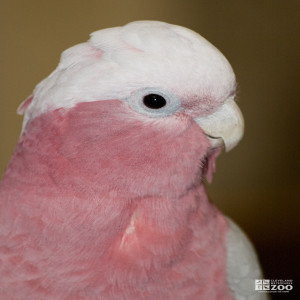Galah
[Eolophus roseicapilla]

Also known as a Rose-breasted Cockatoo, the galah has a back, wings and tail of light gray; head, neck and under-sides of pink. The male has an iris that is almost black, while that of the female is reddish-brown. The beak is a light horn color. They are about 13-1/2 inches long.
Because of the damage they do to crops, the Galah is not a protected species. They are extremely popular cage-birds and often become proficient talkers.
Location: Animals Formerly at Zoo
Share:
Range
The range of the galah is most of Australia.
Habitat
Galahs inhabit savanna woodlands, open grasslands, forested areas, and croplands.
Conservation Status
Least ConcernPrimary Threats
Gestation
Incubation: About 30 days
Litter
Clutch: 2 to 5 eggs
Behavior
Galahs usually move in flocks of varying size, and often these are large, containing hundreds of birds. They sometimes engage in aerial acrobatics during a rainstorm and at sunset before settling down to roost. They feed mostly on the ground, and consume a wide variety of fare. They are very noisy, and fly wildly about, often seeming to race speeding cars as they zoom alongside. Breeding pairs remain as a unit within the flock. Young birds fly very well, but their landings are described as the “crash-landing” variety. They mate for life. The natural call of the Galah is harsh and grating, but in captivity they are silent most of the time.
Reproduction
The natural breeding season of the galah lasts from July to December in southern Australia; and in the tropical north, the birds nest after the wet season, from about February to June. The usual nesting site is a hollow limb or a hole in a tree, standing near water. Nests have been found in holes in cliffs. The hollow is lined with gum leaves, and the birds strip off the bark around the entrance hole, exposing the smooth wood beneath. This habit may be to provide a less easily-climbed surface, and so discourage the attentions of goannas (Varanus lizards). Both sexes incubate in turns. The eggs hatch after about 30 days, and the young are fed by both parents. They leave the nest about 6 weeks after hatching and are fed by their parents for a further 2-3 weeks. After 6 to 8 weeks fledglings have to fend for themselves. Many do not make it. Only about 10 out of 100 survive to breed. Their first 2 to 3 years are spent in flocks of other immature birds.
Wild Diet
Seeds, weeds, vegetable matter, fruit, grain
Zoo Diet
Bird chow, greens, carrot, fruit
